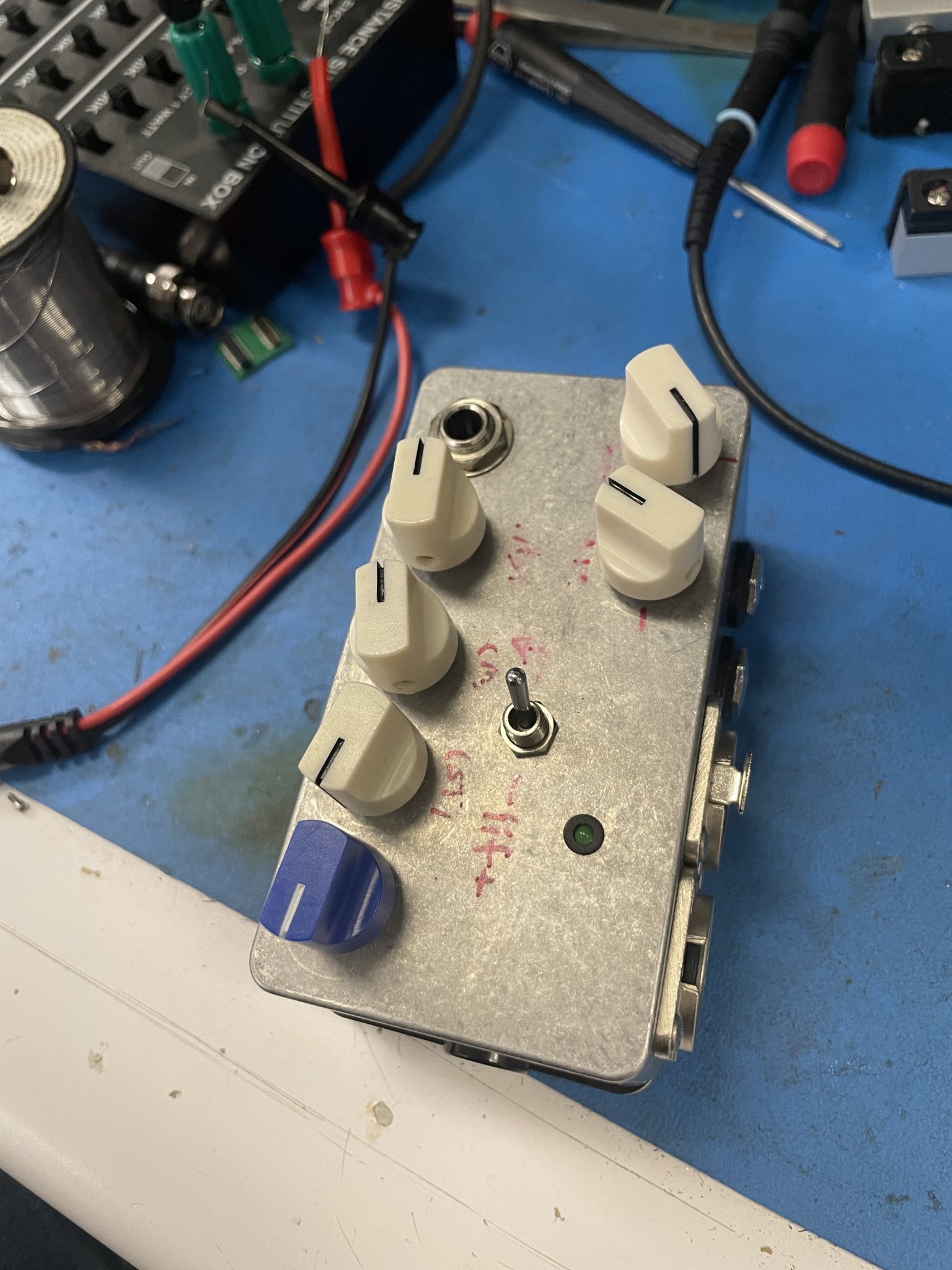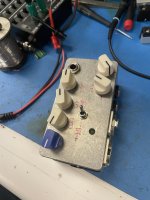I'm building myself a little mixer/headphone driver box for my guitar pedalboard. Among other things, it accepts a balanced line input, which I convert to SE cheaply and, apparently, ineffectively, as I'm getting a good amount of buzz. (from this input only, everything else is quiet and sounds great)
For this input, I'm using a 1/4" TRS jack, and I do have a ground lift switch on the shield, not shown below. (the buzz is worse with the shield not connected to signal ground.) Using a switched jack, I'm connecting the ring to ground via a ~600ohm resistor like this:

When I built this, I thought that the 680 Ohm resistor would be better for the sending source than simply shorting the ring directly to ground, but I'm now wondering if this little arrangement could be the source of my buzz. The buzz is present whether I take the input from a faraway source driven from a different outlet, or from a source plugged into the same outlet that powers the mixer box.
There's no room for a transformer in this design. I could redesign the input circuit to use two balanced buffers, but I feel like there's probably a simpler solution to this. The buzz is definitely getting in at the jack, since turning down the volume on P5 affects the level of the buzz.
Any thoughts on running balanced signals into single-ended inputs? What's the standard wisdom here?
Thanks!
Geoff
For this input, I'm using a 1/4" TRS jack, and I do have a ground lift switch on the shield, not shown below. (the buzz is worse with the shield not connected to signal ground.) Using a switched jack, I'm connecting the ring to ground via a ~600ohm resistor like this:
When I built this, I thought that the 680 Ohm resistor would be better for the sending source than simply shorting the ring directly to ground, but I'm now wondering if this little arrangement could be the source of my buzz. The buzz is present whether I take the input from a faraway source driven from a different outlet, or from a source plugged into the same outlet that powers the mixer box.
There's no room for a transformer in this design. I could redesign the input circuit to use two balanced buffers, but I feel like there's probably a simpler solution to this. The buzz is definitely getting in at the jack, since turning down the volume on P5 affects the level of the buzz.
Any thoughts on running balanced signals into single-ended inputs? What's the standard wisdom here?
Thanks!
Geoff
Last edited:
There is some buzz on the balanced cable, which is surpressed in the balanced pre amp (not shown). With a single ended jack the buzz becomes audiable.
Try to connect P5A with two 'large' non-pol caps (1uF), both feed and ground legs. A low value resistor (1 -- 10 -- 100 ohm?) over the 'ground-cap' can improve (or worsen) things. A transformer, even a small sized one, is always better.
Try to connect P5A with two 'large' non-pol caps (1uF), both feed and ground legs. A low value resistor (1 -- 10 -- 100 ohm?) over the 'ground-cap' can improve (or worsen) things. A transformer, even a small sized one, is always better.
If the input is truly balanced, then you would ideally want the load resistance on both sides to be the same. Without knowing the load on the pot and where it is adjusted to, guessing you would want 5K - 8K for R?
Regarding the load on the ring, yeah, I suppose I could have made it 10k for the source's sake. mainly I just thought it might be bad to short an output to ground. Easy enough to change this.
i suppose a differential input, whether xfmr or active buffer, is the only real solution then, if there really is buzz in the cable. A transformer would be nice and I really like it for robust-ness, but one of the reasons I'm building this box is because the commercial offerings are just too big. So I'm very space constrained, and can't fit one, much less two (it's a stereo input)
i suppose a differential input, whether xfmr or active buffer, is the only real solution then, if there really is buzz in the cable. A transformer would be nice and I really like it for robust-ness, but one of the reasons I'm building this box is because the commercial offerings are just too big. So I'm very space constrained, and can't fit one, much less two (it's a stereo input)
You can spend a few bucks for a try.A transformer would be nice... but... the commercial offerings are just too big.
actually, I suppose building a differential buffer wouldn't even cost me another op amp, as I already have SE buffers on these inputs. Just a few more passives.
(and a board spin :-( )
(and a board spin :-( )
I did find those same transformers in my own googling BTW, but they are 100% too big, haha. It's too bad; I would love to have that galvanic isolation, since those inputs are coming from something external to my pedalboard.
Here's the inside of the box to give you an idea of how much room is available. 🙃


Thanks for the thoughts all!
G
Here's the inside of the box to give you an idea of how much room is available. 🙃
Thanks for the thoughts all!
G
Attachments
Build: AMB Alpha 24 (Size of board is: 1.4” X 2.5”) - you can substitute the thru hole resistors for SMD 1210 size if needed; it is a mono/single channel board.
There are options for buying a fully built board that will serve your purpose but prices escalate and it sounds like you want to stick with budget. The above is very well designed, near state of the art and only a few opamp versions I have seen improve upon on it (i.e. Neurochrome Universal Buffer, etc…). The Neurochrome UB is stereo which makes it more compact.
That being said, both of these suggestions might be too large for your application. And you need a +/- 12V power supply to run them.
Good luck!
Best,
Anand.
There are options for buying a fully built board that will serve your purpose but prices escalate and it sounds like you want to stick with budget. The above is very well designed, near state of the art and only a few opamp versions I have seen improve upon on it (i.e. Neurochrome Universal Buffer, etc…). The Neurochrome UB is stereo which makes it more compact.
That being said, both of these suggestions might be too large for your application. And you need a +/- 12V power supply to run them.
Good luck!
Best,
Anand.
The c**p & EMI reducing advantages of Balanced Lines depend on Balanced Inputs. You haven't got that.
There are simple (1 resistor) methods of producing good Balanced Outputs but not Balanced Inputs. The most convenient method is a Transformer. The best of the chip solutions use the THAT devices.
These need to be between the TRS and P5A
There are simple (1 resistor) methods of producing good Balanced Outputs but not Balanced Inputs. The most convenient method is a Transformer. The best of the chip solutions use the THAT devices.
These need to be between the TRS and P5A
Yeah, fair enough.
I looked at my board, and it's not too bad to modify into a difference amplifier from the current buffer. Four more passives (since there are two channels) and some glue to tack it down. Will have to be careful with the wiring to the connector, but as long as I make the new wires longer than the old ones and tack them down with some epoxy or something I think it'll be ok.
I looked at my board, and it's not too bad to modify into a difference amplifier from the current buffer. Four more passives (since there are two channels) and some glue to tack it down. Will have to be careful with the wiring to the connector, but as long as I make the new wires longer than the old ones and tack them down with some epoxy or something I think it'll be ok.
- Home
- Amplifiers
- Solid State
- Best transformerless method of converting balanced to SE
